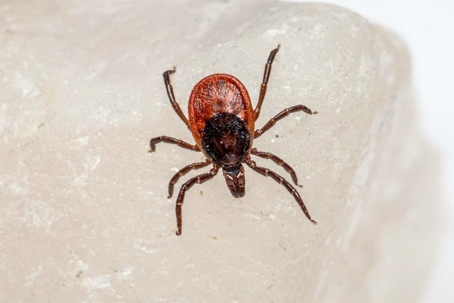What Do Ticks Look Like?
Ticks are small, parasitic arachnids that feed on the blood of animals and humans. Their appearance varies depending on the species and life stage (larva, nymph, or adult), but they share some key identifying features:
Shape: Oval, flat, and slightly rounded when unfed; they become swollen and balloon-like when engorged with blood.
Legs: Adults and nymphs have eight legs, while larvae have six legs (a key way to distinguish them from insects).
Mouthparts: Ticks have a prominent piercing-sucking mouthpart called a hypostome, used to attach firmly to the host and feed on blood. Under magnification, it looks like a small beak or barbed needle.
Learn more: Ticks vs Bed Bugs
How Big Are Ticks?
Ticks are very small arachnids, and their size varies depending on the species, life stage, and whether they have recently fed. In their earliest stage as larvae, often called seed ticks, they measure about 0.5 millimeters—roughly the size of a grain of sand—and have only six legs. Nymphs are slightly larger, about 1 to 2 millimeters, comparable to a poppy seed, and are dark in color, which makes them easy to mistake for specks of dirt. Adult ticks are the largest stage, typically ranging from 3 to 5 millimeters when unfed, or about the size of an apple seed. However, after feeding on a host, adult females can expand dramatically, swelling to 10 millimeters or more—nearly the size of a small grape.
Different species vary slightly in size. Deer ticks, also known as blacklegged ticks, are on the smaller end at about 2 to 3 millimeters, while lone star ticks and brown dog ticks usually range from 3 to 5 millimeters. The American dog tick is among the largest, measuring around 4 to 5 millimeters unfed. When engorged with blood, female ticks can grow two to three times their normal size and change color from reddish-brown to a grayish-blue or silver tone. In summary, unfed ticks are about the size of a pinhead, but once engorged, they can become as large as a pea or small grape, depending on the species and stage of development.
What Color Are Ticks?
Ticks come in a range of colors depending on their species, life stage, and whether they’ve recently fed. Generally, unfed ticks appear in shades of brown, reddish-brown, or black, while engorged ticks—those that have fed on blood—turn gray, bluish-gray, or silver as their bodies swell.
Newly hatched larvae are extremely small and often light brown or tan, making them almost invisible to the naked eye. As they mature into nymphs and adults, their colors deepen and become more distinct. Deer ticks (blacklegged ticks), for example, have reddish-brown bodies with dark black legs and a black dorsal shield (the hard plate near the head). Lone star ticks are reddish-brown, and adult females can be identified by the single silvery-white spot or “star” on their backs. American dog ticks have brown bodies with gray or whitish markings on their backs, while brown dog ticks are uniformly reddish-brown without any distinctive patterns.
When a tick becomes engorged after feeding, its body expands and its color changes dramatically. What was once a small, dark, flat tick can become a rounded, pale, grayish, or even bluish mass. This change occurs because the tick’s translucent skin stretches to accommodate the blood it has consumed.
Most ticks range from light brown to dark reddish-brown when unfed and become gray or blue-gray after feeding. Their coloration and markings can be useful for identifying the species, especially when determining whether they are the type capable of transmitting diseases like Lyme disease or Rocky Mountain spotted fever.

